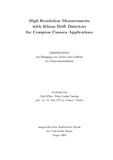Citation link:
https://nbn-resolving.org/urn:nbn:de:hbz:467-892Files in This Item:
| File | Description | Size | Format | |
|---|---|---|---|---|
| conka_nurdan.pdf | 22 MB | Adobe PDF |  View/Open |
| Dokument Type: | Doctoral Thesis | metadata.dc.title: | High resolution measurements with silicon drift detectors for Compton camera applications | Authors: | Çonka Nurdan, Tuba | Institute: | Fachbereich 7, Physik | Free keywords: | Compton camera, silicon drift detector, SPECT | Dewey Decimal Classification: | 530 Physik | GHBS-Clases: | UICD | Issue Date: | 2004 | Publish Date: | 2006 | Abstract: | The accurate and rapid location of the radionuclide distribution in radioactively labeled tissue or organs is the goal of nuclear medicine. The Compton camera, in principle, can improve the spatial resolution and effiency with respect to today's PET and SPECT techniques. Since it is necessary to reconstruct a full scattering event in the Compton camera, the detector technology is very demanding. Useful detectors have not been available in the past. However, a new detector type, the Silicon Drift Detector (SDD), developed for experiments in x-ray astrophysics show promising features. The test of such a system is the main objective of this thesis. The optimization of a Compton camera system in terms of effiency and resolution is a complex multiparameter problem which depends on various detector properties. The influence of these parameters on the performance of the Compton camera system is investigated in this work using the analytical system models and Monte Carlo simulations in order to find optimum detector parameters. Compton camera test setup has been constructed using a 19 channel SDD with onchip JFET as the scatter detector and an Anger camera without a lead collimator as the absorption detector. The equivalent noise charge of the SDD channels at 10 °C with a shaping time of 100 ns was measured to be between 30-40 electrons rms. New readout scheme has been implemented for the fast readout of the detector which is crucial for this application. The system is designed such that the measurements can be done in all detector orientations and kinematical conditions. Compton camera coincidence events with high statistics have been acquired by irradiating the SDD cells with a finely-collimated 1 Ci 137 Cs source. Time, energy and angular distributions of coincidence events measured with this detector system are presented in this work. It is shown that with the scatter detector having an excellent energy resolution, it is possible to reconstruct the source distribution accurately using the locations of the interactions measured in two detectors. Vorrangiges Ziel nuklear-medizinischer Untersuchungen ist die genaue und schnelle Ortsbestimmung der Radionuklidverteilung in radioaktiv markierten Gewebe oder Organen. Gegenüber den heutigen PET und SPECT-Techniken kann der Einsatz einer Compton-Kamera grundsätzlich die Ortsauflösung und die Effizienz verbessern. Weil es notwendig ist, ein ganzes Streuungereignis in der Compton-Kamera zu rekonstrukturieren, ist die Detektortechnologie sehr anspruchsvoll. Brauchbare Detektoren sind in der Vergangenheit nicht verfügbar gewesen. Deshalb, ein neuer Detektortyp, die Siliziumdriftdetektor (SDD), entwickelt für Experimente in der Röntgen-Astrophysik, zeigt erfolgversprechende Eigenschaften. Der Test eines solches Systems ist das Hauptziel dieser Doktorarbeit. Die Optimierung eines Compton-Kamera-Systems bezüglich der Effizienz und der Ortsauflösung stellt ein komplexes Multiparameterproblem dar, welches von verschiedenartigen Detektoreigenschaften abhängt. Um die optimalen Detektorparameter zu bestimmen, wird deren Einfluss auf die Leistungsfähigkeit des Compton-Kamera-Systems in dieser Arbeit anhand von analytischen Systemmodellen und Monte-Carlo-Simulationen untersucht. Ein Comptonkameratestaufbau wurde mit einem 19-kanäligen SDD mit direkt implementierten JFETs als Streudetektor und einer Anger-Kamera ohne Bleikollimator als Absorptionsdetektor realisiert. Das equivalente Ladungsrauschenen der SDD Kanäle wurde bei 10 °C und einer Pulsformzeitkonstant von 100 ns zu 30 - 40 Elektronen rms gemessen. Ein neues Konzept wurde für die schnelle Detektorauslese, welche für diese Anwendung wichtig ist, entwickelt. Das System ist so ausgelegt, dass die Messungen in jeder Detektororientierung und unter beliebigen kinematischen Bedingungen durchgeführt werden können. Compton-Kamera-Koinzidenzen bei hoher Statistik wurden durch Bestrahlen der SDD-Zellen mit einer fein-kollimierten 1 Ci 137 Cs aufgenommen. Mit diesem System gemessene Zeit-, Energie- und Winkelverteilungen von Koinzidenzen werden in dieser Arbeit vorgestellt. Es wird gezeigt, dass es mit dem Streudetektor, welcher eine hervorragende Energieauflösung aufweist, möglich ist, mit der Ortsbestimmung in zwei Detektoren die Quellenverteilung genau zu rekonstruieren. |
URN: | urn:nbn:de:hbz:467-892 | URI: | https://dspace.ub.uni-siegen.de/handle/ubsi/89 | License: | https://dspace.ub.uni-siegen.de/static/license.txt |
| Appears in Collections: | Hochschulschriften |
This item is protected by original copyright |
Page view(s)
455
checked on Nov 28, 2024
Download(s)
116
checked on Nov 28, 2024
Google ScholarTM
Check
Items in DSpace are protected by copyright, with all rights reserved, unless otherwise indicated.

